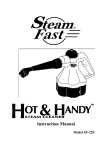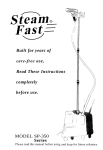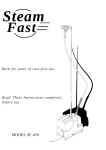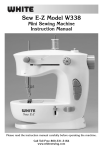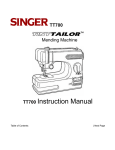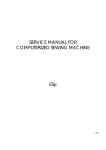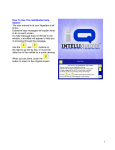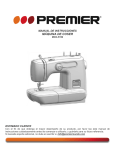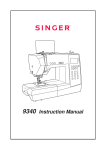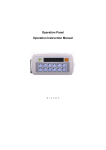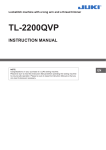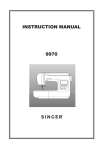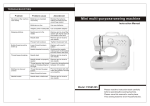Download Top Innovations SP-402 User's Manual
Transcript
Top Innovations, Inc. Innovative Products to Make Your Life Easier Model SP-402 Owner’s Manual THIS IS NOT A TOY! Adult supervision recommended Item contains sharp functional points and small parts Machine Sewing in Minutes Adjustable Stitch Length Sews with a Durable Lockstitch Top Innovations, Inc. 400 NW Platte Valley Drive Riverside, MO 64150 (800) 711-6617 (816) 584-9700 Fax: (816) 584-9066 www.topinnovations.com Dear Valued Customer: Thank you purchasing your Quikstitch Sewing Machine from our rapidly growing Sew Pro line. Our firm takes pride in providing you with quality, value, and excellent service. The QuikStitch Sewing Machine will become a valuable tool that will keep your family’s wardrobe in shape. Although not designed to make complicated clothing from scratch, it performs all of your basic sewing jobs quickly and will provide a quality stitch. This machine was specifically designed to be light and compact for easy portability. We are confident you will enjoy the time you spend using our product. Top Innovations, Inc. would like to invite you to take advantage of our customer support web site at www.topinnovations.com. Here you will find additional information about the many other exciting Sew Pro and Steam Fast products that are available. We take pride in our quality line-up of garment care and steam cleaning products and hope you will visit our web site to review our product line. Benny Lee Chairman and CEO, Top Innovations, Inc. 2 QUIKSTITCH PARTS AND ACCESSORIES 3 ACCESSORIES INCLUDED 1. In Accessory Drawer in front of machine 3 Bobbins (1 in machine) For replacement, use class 66 bobbins 1 needle threader 2 needles (1 in machine) For replacement needles, use size 14 needles Combination seam ripper/thread trimmer 2. AC Adaptor 3. Foot Pedal 4 NOTE: Even if you have sewn before, these instructions will make your first use much easier! TABLE OF CONTENTS PAGE Handy Reference Guide.................................................................2 Getting Ready to Sew ....................................................................6 Winding the Bobbin ........................................................................7 Inserting the Wound Bobbin...........................................................9 Threading the Machine ..................................................................10 Raising the Bobbin Thread.............................................................12 Sewing a Broken Seam..................................................................13 Securing a Seam............................................................................14 Free Arm Sewing............................................................................14 Adjusting Tension...........................................................................15 Changing Needles..........................................................................16 Bobbin Case Replacement ............................................................17 Performance Checklist ...................................................................18 Limited Warranty ............................................................................19 IMPORTANT SAFEGUARDS Before connecting machine, be sure that the voltage on the AC adaptor matches your electrical supply Always disconnect the foot pedal or AC adaptor when changing needles, removing the bobbin, or cleaning the QUIKSTITCH Always disconnect the AC adaptor whenever the QUIKSTITCH is unattended Work carefully and watch the sewing area to avoid the needle during operation Do not pull the fabric while sewing as the needle may bend, break or cause other damage Insure that the machine is threaded correctly before sewing The QUIKSTITCH is a sewing machine and is not intended for garment construction 5 GETTING READY TO SEW 1. Assemble spool holder by snapping spool pin into spool stand. Both of these parts are found in accessory drawer located in front of machine 2. Slide spool stand into its holder on rear left of machine, until it snaps firmly into place 3. Make sure that power switch is in the “O” (Off) position. Plug in the foot pedal and AC adaptor plug 4. Remove the red-handled seam ripper/thread trimmer and needle threader from accessory drawer 6 WINDING THE BOBBIN 1. Push the bobbin winder switch down to raise bobbin winder 2. Remove see-through bobbin cover by sliding it toward the front of machine. Insure that the bobbin case is in the proper position. The bobbin case is held in place by a position plate, which is designed to flex slightly to allow the bobbin case to move back and forth freely, about 1/16”. The screw head should line up with the seam in plastic casing of machine and bobbin case should move back and forth slightly (about 1/16”) when hand wheel is turned. If not, refer to page 17 for repositioning instructions. 3. Remove empty bobbin from bobbin case. The seam ripper may make removal easier. Place bobbin on the bobbin winder, aligning the hole in bobbin with the driving pin on bobbin winder. You may have to turn the hand wheel to help locate the driving pin. 4. Slide spool of thread onto the spool pin. NOTE: Make certain that the thread retaining slit on spool is near the bottom. Otherwise, thread can become caught in the slit and cause problems during sewing. 7 5. Pull thread from spool and, using two hands, pull it through the diagonal slit in first thread guide First thread guide should look like this when properly threaded. 6. Wrap thread one time counterclockwise around tension disc. 7. Feed end of thread through small hole in top of bobbin from the inside, leaving a 3” tail. 8. Slide power switch into “1” (On) position. Hold the end of the thread (the “tail”) firmly and step on foot pedal until a few coils are wound onto bobbin and stop. 9. Use the thread trimmer to cut off tail, so it is flush with the top of the bobbin. Continue winding until the desired amount of thread is wound onto bobbin. A full bobbin holds 35 yards. 10. Cuts thread about 4” from the bobbin and remove it from the machine. Leave the spool of thread on spool pin on back of machine. Push bobbin winder switch up into “Off” position. 8 INSERTING THE WOUND BOBBIN 1. Insert wound bobbin into bobbin case with thread spooling off to left side, as shown. 2. Guide end of thread to the back of the bobbin. 3. Pull the thread toward you so that it hooks on notch A (at 3 o’clock position) and then pull to the left so that it passes through notch B (at 4 o’clock position) 4. Leave several inches of thread laying across top of bobbin toward the left of machine. Bobbin threading is now complete. (See page 12 to raise lower thread for sewing) 9 THREADING THE MACHINE There are six thread guides that the top thread passes through. The diagram at right shows an overview of the threading procedure; refer to the specific instructions below for important details. Your spool of thread should be in the same position as it was for winding the bobbin- on the spool pin on the back of the machine. Cut the thread near the spool and pull the tail out of the thread guide and tension disc. 1. Pull thread from spool, (using two hands); pull it through diagonal slit in thread guide “A”. Do not wrap thread around tension disc for sewing. Thread guide “A” should look like this when properly threaded. 2. Hold thread firmly against top of machine between thread guides “A” and “B” and pull down in between two silver discs. 3. Feed the thread under disc thread guide “C” and through opening created by guide bar. Insert thread from right to left. Leave some slack in the thread to the right. 10 4. Grasp slack thread (while removing slack); guide the thread into the center groove in disc thread guide “C”. NOTE: Make sure that thread does not slip behind the guide. Pull about 6” of thread through and ensure that the threading is correct up to this point. 5. Turn the hand wheel toward you until take-up lever is in its highest position. Pass the thread through the hole in take-up lever “D” from right to left. 6. Turn the hand wheel toward you so that needle lowers and the thread guide “E” is accessible. Place the thread behind the thread guide “E” to the right side and pull forward. The thread guide will thread itself. 7. Turn the hand wheel toward you again to raise the needle to its highest position. Feed wire needle threader through needle eye from right to left. Insert thread through wire loop and pull needle threader through the needle eye. Now pull thread back to the right. The needle is now threaded. 11 RAISING THE BOBBIN THREAD 1. Hold top (needle) thread and turn hand wheel toward you until needle goes to its lowest and then its highest point. Raise the presser foot using the presser bar lifter. 2. Gently pull top (needle) thread until lower (bobbin) thread comes up in the form of a loop. 3. Use the flat side of seam ripper/thread trimmer to open up bobbin thread loop until end is visible. 4. Pull both thread tails straight back under presser foot. 5. Replace see-though bobbin cover by sliding it back into place. You are now ready to sew! 12 SEWING A BROKEN SEAM 1. Set the stitch control knob to the desired stitch length. For most sewing, the “long stitch” setting is acceptable. Turn hand wheel toward you to raise the needle to the highest position. 2. Lift presser foot using presser bar lifter. Make sure that both needle (top) thread and bobbin (lower) thread are pulled straight back behind needle about 4”. 3. Position area to be sewed under presser foot. Turn the hand wheel toward you to lower the needle into existing stitches in fabric. Lower presser foot. 4. Step on foot pedal and the machine will start to sew the broken seam. Continue until new stitches are about an inch past the area to be sewed and then step off the foot pedal. 5. Raise presser foot using presser bar lifter and pull fabric straight back. Cut both threads about 4” from the edge of the fabric. NOTE: If it is difficult to pull thread toward back without noticeably bending the needle, a slight backward and forward movement of the hand wheel will make it easier to remove the fabric. 13 SECURING A SEAM There are two methods of securing the threads at the start and the end of the repaired seam. METHOD #1 : Backstitching Turn the stitch control knob to REVERSE (left) position and backstitch 4-5 stitches at start and end of seam repair. METHOD #2: Tying off When seam is completed, use needle threader to pull top thread to underside of fabric. Tie a square knot with the bobbin thread and trim. FREE ARM SEWING The QUIKSTITCH has a free arm for sewing sleeves, pant legs, etc .. To utilize this handy feature, just slip the item onto the free arm. 14 ADJUSTING TENSION All tension adjustment is accomplished by using the needle thread tension dial. The bobbin case tension is pre-set at the factory and cannot be adjusted. ALWAYS DOUBLE CHECK THREADING BEFORE ATTEMPTING TO ADJUST TENSION! The tension level may be determined by using two different color threads for the needle and bobbin threads, and then analyzing the resulting stitches. When an even amount of thread is exerted on both threads, a smooth, even stitch known as a balanced stitch is produced. A perfect, balanced stitch will have the needle and bobbin threads locked between the two layers of fabric with no loops on top or bottom and no puckering. Too much tension will produce a tight stitch, which will cause the fabric to pucker. To decrease tension, turn the tension dial downwards. Too little tension will produce a loose stitch, which will cause loops in your seam. To increase tension, turn the dial upwards. 15 CHANGING NEEDLES IMPORTANT: use size 14 needles. 1. Turn hand wheel to raise needle to its highest position. Loosen the needle clamp screw just enough to remove needle. A small screwdriver may be helpful. 2. With flat side of needle to the right (same side as needle clamp screw), insert new needle up into the clamp as far as it will go. 3. Re-tighten the needle clamp. 16 BOBBIN CASE REPLACEMENT A special feature of the QuikStitch is the anti-thread jamming bobbin case. The bobbin case is held in place by a positioning plate which is designed to flex slightly to allow the bobbin case to move back and forth freely, about 1/16”. In the event that the bobbin case becomes displaced and does not move freely or pops out completely, follow the three easy steps below. STEP 1: Remove bobbin from bobbin case. If bobbin case has popped out, put back in position as follows: Place bobbin case under position plate so that screw head is under notch in position plate. Then, slide the bobbin case around until the metal bracket sits between 2 o’clock and 4 o’clock positions. Proceed to step 2. STEP 2: Use left index finder to pull bobbin case toward the right and up, until lower half of metal bracket touches the angled edge of the position plate. Rotate the hand wheel until the bobbin case rests in its correct position. Proceed to step 3. STEP 3: Check bobbin case for proper positioning. The screw head should line up with the seam in the plastic casing of the machine. From side view, the top of the bobbin case will be level with (or slightly above) the position plate. 17 PERFORMANCE CHECKLIST When sewing difficulties occur, refer back to this manual to make sure that you are correctly following the instructions. If you are still having a problem, the reminders below may help you solve the problem. Needle does not move Is machine connected to electrical supply? Is foot pedal connected? Is bobbin case displaced (pg.17)? Is thread correctly lead around bobbin winder tension disc? Upper thread breaks Is machine properly threaded? Is thread freely unwinding from spool? Needle moves, but stitch is not Is needle size correct for thread? formed Is upper thread tension too tight? Is needle in backwards? Is bobbin case properly inserted (pg. 17)? Is needle defective? Is needle fully inserted into needle Is bobbin rim free of nicks? clamp? Lower thread breaks Are bobbin and needle correctly threaded? Is bobbin correctly wound? Is bobbin correctly inserted into Is bobbin correctly inserted into bobbin case? bobbin case? Is bobbin case correctly threaded? Needle breaks Is bobbin case properly inserted (pg. 17)? Is needle straight and sharp? Is needle correct size? Is needle fully inserted into needle Skipped stitches Is machine properly threaded? clamp? Is fabric firmly held down? Bobbin winding difficulties Is needle correct size? Is thread unwinding freely from Is needle straight and sharp? spool? Fabric does not move properly Is bobbin winder engaged? under presser foot Is thread end securely held at Is presser foot lowered? start of wind? Is stitch length correctly set? QUESTIONS? If you have questions about any aspect of threading or sewing with the QUIKSTITCH call: Customer Support Contact our Customer Support Team at Top Innovations, Inc. at (800) 7116617 or (816) 584-9700. E-mail us at [email protected] or visit our web site at www.topinnovations.com 18 LIMITED WARRANTY Top Innovations, Inc. will repair or replace, at its option, without charge to the consumer any SEW PRO£ product that fails due to a defect in material or workmanship within 90 days following the initial consumer purchase. This warranty does not cover damage caused by commercial use, misuse, alteration, or modification. Performance of any obligation under this warranty may be obtained by returning the warranted product, freight prepaid, with dated proof of the purchase to: TOP INNOVATIONS, INC. Warranty Service Department 400 NW Platte Valley Drive Riverside, MO 64150 If you have any questions about coverage under this warranty, you may contact the Warranty Service Department by telephone at 800-711-6617 or email: [email protected]. This warranty gives you specific legal rights, and you may also have others rights which vary from state to state. 19 Printed in China Top Innovations, Inc. 400 NW Platte Valley Drive • Riverside, MO 64150 (800) 711-6617 (816) 584-9700 Fax: (816) 584-9066 www.topinnovations.com 20 IMPORTANT! "THREADING THE MACHINE" INSTRUCTION MANUAL SUPPLEMENT Needle Threader The purpose of this insert is to supplement the information given in the "Threading the Machine" section on pages 10 & 11 of the instruction manual. Specifically, it is meant to clarify steps 3 & 4 by illustrating the necessary procedures in further detail. Follow the steps below, in combination with the information given in the instruction manual, to properly thread the machine. NOTE: Refer to the illustrations on the other side of this sheet for assistance in completing the following steps. 1) Feed the thread around the Guide Bar located at the 3 o'clock position on the Disc Thread Guide (FIGURE 1). 2) Insert the Needle Threader down through the Guide Bar that is located at the 9 o'clock position on the Disc Thread Guide (FIGURE 2). 3) Feed the slack end of the thread through the Needle Threader (FIGURE 3). 3 o'clock Guide Bar 9 o'clock Guide Bar FIGURE 1 FIGURE 2 FIGURE 3 FIGURE 4 4) Pull Needle Threader (with thread inserted) back up through the Guide Bar (FIGURE 4). 9 o'clock Position Guide Bar Disc Thread Guide SHORT STITCH LONG STITCH QUIKSTITCH TM 3 o'clock Position Guide Bar





















